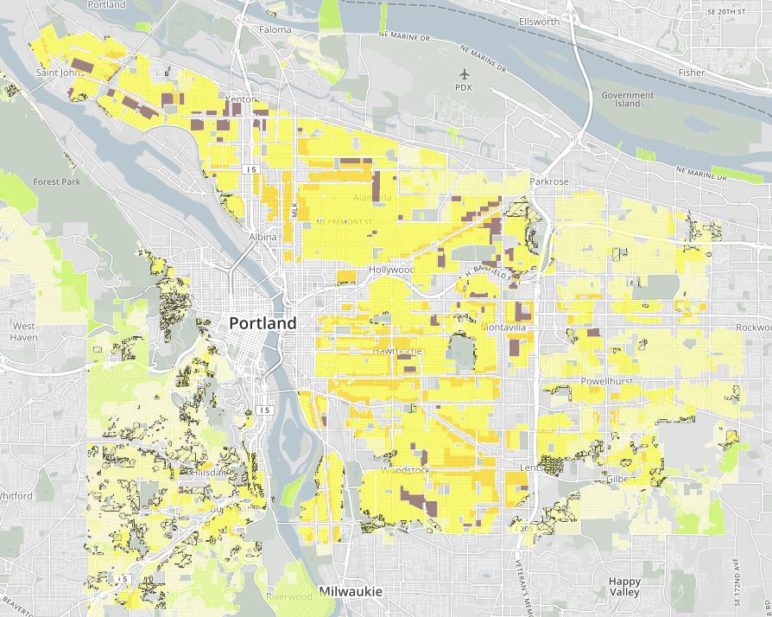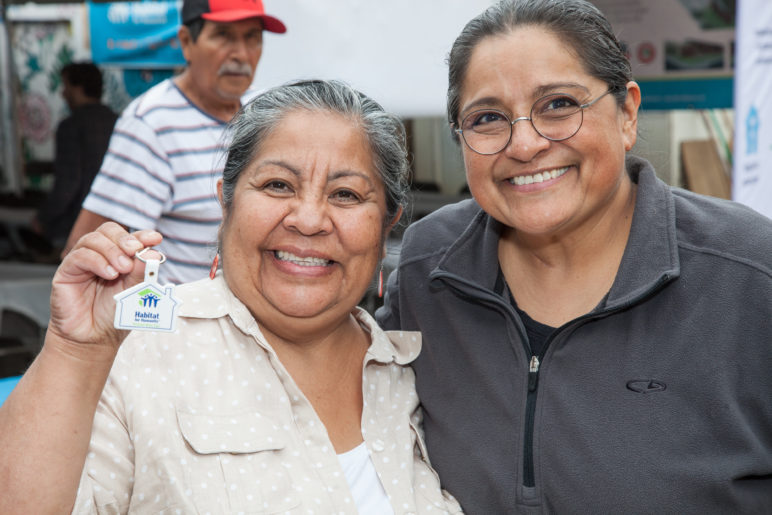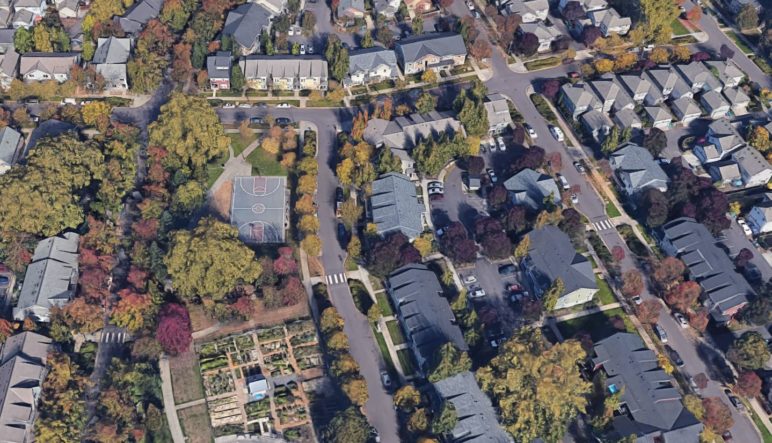For years, three-quarters of Portland’s residential land has been almost entirely off-limits to anyone—a nonprofit developer, a government agency, anyone—who wants to build new guaranteed-affordable housing.
These no-go zones for affordable-housing projects are marked in yellow, orange, brown and light green in the map below.

Cascadia’s third-largest city has plenty of affordable housing developers: Habitat for Humanity, Portland Community Reinvestment Initiatives, Catholic Charities and a cluster of community development corporations: Hacienda, ROSE, REACH. But because of Portland’s laws, none of them are building in the areas marked above.
Why on earth would a city, especially one suffering from a widely acknowledged crisis in the price of housing, do this to itself?
The reason is simple: That’s a map of Portland’s low-density residential zones, from which the city mostly banned duplexes, triplexes and fourplexes in 1959.
In areas where Portland prevented the private sector from building the sort of urban homes that people in the middle class can afford, it also prevented the public sector from building the sort of homes poor people can afford. As Portland has prospered economically and space in the city has become more precious, this obstacle has loomed larger and larger.
But what if the city were to change that?
What if Portland were to not only re-legalize market-rate fourplexes affordable to the middle class (a public-school teacher, a bartender, a firefighter) but also create an option specifically intended to create below-market homes immediately affordable to poorer folks like a home-health aide, a day-care provider or a fixed-income retiree?
Building bigger means building cheaper
These days, for almost anyone trying to build the sort of subsidized homes that’d be affordable to truly low-income Portlanders, the costs in low-density zones are essentially insurmountable. Creating a fairly average-size detached home—1,600 square feet—in a close-in neighborhood like Portland’s Brooklyn area would cost $300,000 just for the land, because any buildable lot would almost certainly already contain an old house. Then it’d cost another $479,000 to develop, build and sell.
If you wanted to subsidize that project until the related mortgage and utility payments were affordable to a family making 60 percent of median income, the public would need to cover 72 percent of the cost of that home: $563,338.
 Simply put: With thousands of Portlanders in desperate need of better housing, this would not be a very good use of public money. This is far more than the $167,000 per home created or preserved by the Portland region’s recent housing bond—spending this much to house one household would mean failing to serve two or three others.
Simply put: With thousands of Portlanders in desperate need of better housing, this would not be a very good use of public money. This is far more than the $167,000 per home created or preserved by the Portland region’s recent housing bond—spending this much to house one household would mean failing to serve two or three others.
That’s why nobody in Portland is building below-market oneplexes—and that’s why below-market housing development has been essentially banned from most of the area in the map above, where oneplexes are the only legal option.
But what if fourplexes were an option?
It turns out that for the same reason that market-rate fourplexes tend to be cheaper than market-rate oneplexes, duplexes or triplexes, below-market fourplexes require less subsidy than below-market oneplexes, duplexes or triplexes.
Not only does an affordable housing developer like Habitat for Humanity get to split the land cost four ways, they also spread the costs of condoization and site preparation. This is the result:
 Portland’s affordable housing developers have been pointing this out for years. It’s why they endorsed state-level legalization of market-rate fourplexes last spring—because, as they pointed out, the rules would let nonprofit builders house far more Portlanders below the market rate, too.
Portland’s affordable housing developers have been pointing this out for years. It’s why they endorsed state-level legalization of market-rate fourplexes last spring—because, as they pointed out, the rules would let nonprofit builders house far more Portlanders below the market rate, too.
But a $200,000 subsidy per home is still a lot of money—more than most housing nonprofits can find under most circumstances.
That leads to an interesting question.
What if, in Portland’s search for ways to create below-market housing in areas near the best transit, schools and jobs, it’s been thinking … too small?
For the last few months, a pair of Portland housing advocates, Neil Heller and Madeline Kovacs, have taken on a volunteer project to find out just how low that orange bar can go. Kovacs, a Sightline outreach associate and a co-founder of the advocacy group Portland: Neighbors Welcome connected Heller, a Portland-based faculty member of the Incremental Development Alliance, with nonprofit developers at Habitat for Humanity Portland/Metro East, the local community land trust Proud Ground, Portland Community Reinvestment Initiatives and ROSE Community Development Corporation.
Using the cost figures and regulatory constraints provided by those nonprofits, Heller ran the numbers on what it might cost those nonprofits to build more deeply affordable homes in bigger buildings, if only the city let them.
According to the figures, it helps quite a lot. Allowing three-story sixplexes, with each home an 1,100 square foot three-bedroom, would reduce the public subsidy per unit by another 28 percent.
 This brings the figure below the magic number of $150,000 that the Portland Housing Bureau sets as its maximum subsidy for new below-market homes.
This brings the figure below the magic number of $150,000 that the Portland Housing Bureau sets as its maximum subsidy for new below-market homes.
Using the same building size, there’s another option too: we could allow some of the homes to be smaller (still including one family-size home, but bringing the average unit size down to 800 square feet). This would let the project divide its costs eight ways and also (because of the smaller sizes) sharply reduce construction cost per home.
This combination brings the per-unit subsidy significantly lower.
 For any of these examples except the last, a would-be homebuyer earning up to 60 percent of Portland’s median income would be taking out the same mortgage: $282,597 before down payment assistance of up to $80,000 per home.
For any of these examples except the last, a would-be homebuyer earning up to 60 percent of Portland’s median income would be taking out the same mortgage: $282,597 before down payment assistance of up to $80,000 per home.
At current interest rates, that’d come to a monthly mortgage payment of $1,390 per month for one of these three-bedroom homes in an inner Portland neighborhood.
(In the case of the eightplex, the buyer’s price would be lower for the smaller homes.)
In other words: A “deeper affordability” option would make public dollars far more efficient—and every project could house many more people.
“The cool thing is that zoning changes are technically free,” Heller said in an interview.
A potential homeownership lifeline for less wealthy Portlanders

Steve Messinetti, the local Habitat CEO, said his organization is strongly in favor of a “deeper affordability” option in the residential infill project.
“The key thing for us and for others is that if we’re serious about addressing the minority homeownership gap, we need to be looking for ways to serve under-60-percent households,” Messinetti said, referring to Portlanders making less than 60 percent of the median income.
In Portland as of 2017, the median household brings in $58,423 per year, but the median Black household has an income of $26,675, the median Native American household $29,859 and the median Latino household $40,982.
“All affordable housing currently needs more than $100,000 in subsidy to work,” Messinetti said. “If we can get that subsidy down, our dollars that go to that are going to go a lot further. … We’re doing a project in Northeast [Portland] right now where we’re doing $125,000 in city subsidy per door to make it work. If we only needed $60,000, we could have built twice as many homes.”
Three-quarters of local Habitat homebuyers are people of color, and most are earning 30 to 50 percent of the area’s median income, so currently as little as $23,760 for a family of three. (In Portland, that’s one full-time job at minimum wage.) Habitat could take advantage of the deeper affordability option while making homeownership projects affordable to that family thanks to help from volunteers and private subsidies.
“The other option is that people are continuing to move further and further out and continuing to see the problems that we’ve seen with traffic and the cost of living,” Messinetti said. “Quality of life is getting worse and worse because the people who run our city are not able to afford to live in it.”
Hundreds of potential new affordable rentals in inner Southeast Portland alone
According to Heller’s numbers, the “deeper affordability” sixplex-eightplex option wouldn’t be any more viable than the fourplex option for most nonprofits that specialize in below-market rentals, like East Portland’s ROSE CDC. That’s because so much the cost of rentals is caught up in their maintenance and operation.
(Fourplexes, sixplexes and eighplexes would all be far more viable than oneplexes, though.)
But there is one organization in Portland that specializes in rental housing and could gradually deliver huge results from the “deeper affordabilty” option: REACH CDC, ROSE’s peer organization that works in inner Southeast Portland.
That’s because, unlike most developers, REACH doesn’t have to acquire new land. It already owns, operates and subsidizes 60 low-density properties in inner Southeast Portland, acquired decades ago when the area’s biggest housing problem was disinvestment.
“The price of land in really good transit-oriented sites is getting so expensive,” said Dan Valliere, REACH’s CEO. A “deeper affordability” option in Portland’s residential infill project, he said, would “create some opportunities over time for REACH to redevelop those in a slightly more dense way.”
Beyond that, Valliere said, REACH’s residents get another huge benefit from affordable homeownership programs: it gives them somewhere to move to.
“Every year there are people who live in a REACH rental who end up leaving because they’re buying a home,” Valliere said. “That’s not everybody’s goal; there are many many other REACH renters whose goal is to live out their life there, and that’s great.”
But for those who do want to buy, there are few options near their longtime home.
“One of the big problems right now is finding a place,” Valliere said. “People can get organized, they have a little down payment even, they have a steady income. They live in affordable housing, which allows them to save, but they still struggle to find a place. … So my only choice is to move 80 miles away?“
“This could be a really helpful thing for residents at REACH, those who are saving for a home,” Valliere said.
The equivalent of cutting a $150,000 check to every new affordable home

Last month, Portland’s city council approved a different reform to mid-density zones, called Better Housing by Design, that will allow mixed-income rentals in many more areas.
Unlike the residential infill project, which is projected to reduce demolition-related displacement of low-income renters, that reform was projected to increase it.
But Portland’s progressive housing community supported the Better Housing by Design reform anyway, largely because it included generous provisions for a “deeper affordability” option—letting buildings be twice as big if at least half the homes inside were affordable at 60 percent of median income.
But Portland’s reform to its low-density zones has never had such a provision, essentially because of a perception that it would be politically impossible to allow three-story sixplexes or eightplexes on some properties in Portland’s longtime no-go zone for affordable housing.
Even if doing so were (compared to the current fourplex option) the financial equivalent of cutting a check for $150,000 to every single one of those new homes, at zero additional cost to the public.
The work of housing advocates like Heller calls that perception into question. If Portland wants to gradually create hundreds of homes in low-density zones that are immediately and permanently affordable to low-income people without vastly increasing its housing budget, he thinks this is how.
Portland: Neighbors Welcome, the group Heller and Kovacs volunteer for (full disclosure: I do, too) is mobilizing Portlanders to testify in support of this proposal, both in person and online. The hearing is next week.
“We didn’t pre-negotiate ourselves based on fear of what’s palatable,” Heller said. “I think there’s some value in just objectively saying, ‘What does it take?’ Do the math and understand it from there.”

